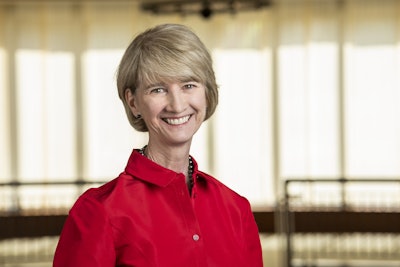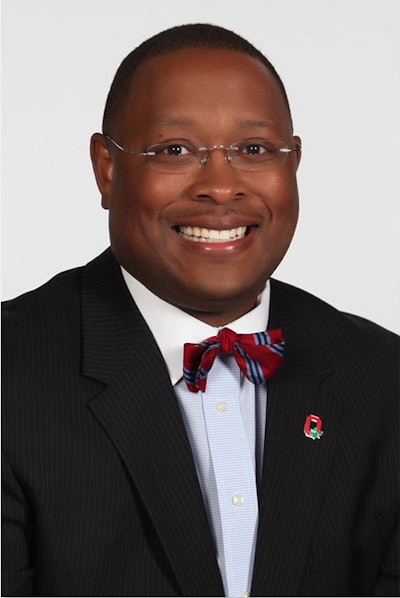In her first state of the university address, Dr. Kristina M. Johnson, president of The Ohio State University, announced a new initiative called RAISE: race, inclusion and social equity, that includes a pledge to hire 50 scholars who address social equity and racial disparities in their work as well as 100 faculty members from underrepresented backgrounds across all fields. All new openings will be tenure-track positions.
“This means a lot to me,” Johnson said in her address. “As a young woman studying engineering in the 1970s, it took me a long time to realize that I could become a professor too, because I never had a woman professor in any of my basic science, math or engineering coursework … I want every single Ohio State student to be able to look across the lecture hall or seminar table and understand immediately that their dreams are valid and achievable.”
 Dr. Kristina M. Johnson
Dr. Kristina M. JohnsonTo support the new faculty, the university will group scholars into hiring cohorts with a focus on helping underrepresented scholars network across disciplines.
“Ultimately, the RAISE initiative will bring to Ohio State researchers who develop new approaches to building an anti-racist society, while changing the composition of our faculty and transforming our own culture, practices and policies so that Ohio State becomes an absolutely inclusive community,” Johnson said.
The initiative is a part of a larger push to hire at least 350 tenure-track faculty members within ten years. According to Johnson, undergraduate enrollment rose by 5,800 students since 2008, while the net number of tenure-track faculty dropped by 219 during the same period.
Dr. Donna Y. Ford, distinguished professor of education at The Ohio State University, was “ecstatic” about the new initiative. Hearing Johnson’s address, “it just made my chest swell,” she said.
Ford came back to Ohio State after serving as a professor at Vanderbilt University. For her, the initiative was confirmation that returning to the institution was the right choice.
 Dr. Donna Y. Ford
Dr. Donna Y. Ford“I was blown away with pride that our president is so visionary and very unapologetic about her commitment in word and deed to equity, diversity and inclusion,” she said. “It felt very needed and very refreshing.”
To Ford, the fact that these are tenure-track roles felt significant, especially in a higher education landscape increasingly dependent on adjunct and part-time instructors. Studies show women and underrepresented minorities tend to be concentrated in non-tenure track positions.
Offering a path to tenure sends a message that the initiative is “not only to recruit diverse faculty but to retain them,” Ford said. Tenure-track positions offer a “sense of security and a belief that there’s going to be a long-term commitment to them … and them to the institution.”
She also thinks an influx of faculty focused on equity issues and faculty from underrepresented backgrounds will create a community of scholars who can magnify each other’s work.
 Dr. James L. Moore, III.
Dr. James L. Moore, III.“Too often, at predominantly White institutions, it is very lonely and isolating to be one of the few voices consistently addressing equity, diversity and inclusion,” she said. “Now there will be more people to connect with and collaborate with so the impact can be greater, exponentially so.”
Dr. James L. Moore, III, vice provost for diversity and inclusion and chief diversity officer at The Ohio State University, emphasized that this initiative isn’t just about diversifying the faculty but diversifying the student body as well, because minority faculty ultimately attract diverse students. He’s also a professor of education and human ecology and a distinguished professor of urban education.
“Too often universities would spend so much time on [recruiting] the students, and then we get them here and struggle to retain them or give them a quality experience where they’re able to access mentors who look just like them …,” Moore said. “We know that there are immense benefits when we have a diverse workforce.”
He noted that investing in so many new faculty positions will likely require “additional resources or a re-prioritization of resources” but “like all institutions, whatever we value, we find the money for.”
As university hiring freezes continue, in light of the COVID-19 pandemic, Ford hopes the RAISE initiative can serve as an example for other institutions.
“I want other presidents, provosts, to follow President Johnson’s lead,” she said, “because I’m so tired of people in higher education, as well as K-12, pretending that the funding is not available when they just have to be very strategic about how they allocate funds …. It shows what they prioritize.”
As a campus with over 50,000 students, Moore sees The Ohio State University as having a critical role to play in efforts to “eliminate racism and disparities of all kinds.”
“That’s a lofty goal and somewhat aspirational,” he said, “but that’s nothing new for institutions of higher learning to be lofty and aspirational.”
Sara Weissman can be reached at [email protected].



















